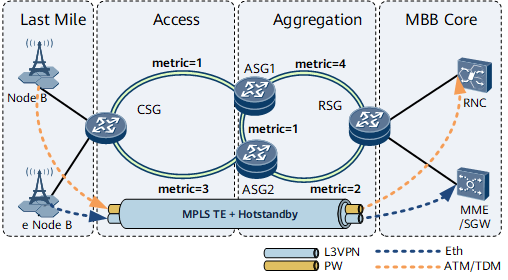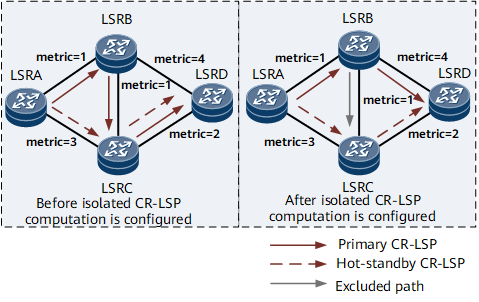Isolated CR-LSP Computation
Isolated CR-LSP computation enables a device to compute isolated primary and hot standby CR-LSPs using the disjoint algorithm and constrained shortest path first (CSPF) algorithm simultaneously.
Background
Most live IP radio access networks (RANs) use ring topologies and have the access ring separated from the aggregation ring. Figure 1 illustrates an E2E VPN bearer solution. On this network, an inter-layer MPLS TE tunnel is established between a cell site gateway (CSG) on the access ring and a radio service gateway (RSG) on the aggregation ring. The MPLS TE tunnel implements E2E VPN service transmission. To meet high reliability requirements for IP RAN bearer, hot standby is deployed for the TE tunnel, and the primary and hot standby CR-LSPs needs to be separated.
However, the existing CSPF algorithm used by TE selects a CR-LSP with the smallest link metric and cannot automatically calculate separated primary and hot standby CR-LSPs. Assume that the TE metric of each link is as shown in Figure 1. CSPF calculates the primary CR-LSP as CSG-ASG1-ASG2-RSG, but cannot calculate a hot standby CR-LSP that is completely separated from the primary CR-LSP. However, two completely separated CR-LSPs exist on the network: CSG-ASG1-RSG and CSG-ASG2-RSG.
Those two completely separated CR-LSPs can be obtained by specifying strict explicit paths. In real-world situations, nodes are frequently added or deleted on an IP RAN. The method of specifying strict explicit paths requires you to frequently modify path information, causing heavy O&M workload.
An ideal solution to the problem is to optimize CSPF path calculation so that CSPF can automatically calculate separated primary and hot standby CR-LSPs. To achieve this purpose, isolated CR-LSP computation is introduced.
Implementation
Isolated CR-LSP computation uses the disjoint algorithm to optimize CSPF path calculation. On the network shown in Figure 2, before the disjoint algorithm is used, CSPF selects CR-LSPs based on link metrics. It calculates LSRA-LSRB-LSRC-LSRD as the primary CR-LSP, and then LSRA-LSRC-LSRD as the hot standby CR-LSP if the hot standby overlap-path function is configured. These CR-LSPs, however, are not completely separated.
After the disjoint algorithm is used, CSPF calculates the primary and backup CR-LSPs at the same time and excludes the paths that may cause overlapping. Two completely separated CR-LSPs can then be calculated, with the primary CR-LSP being LSRA-LSRB-LSRD, and the hot standby CR-LSP being LSRA-LSRC-LSRD.

CSPF calculates separate primary and hot standby CR-LSPs only when the network topology permits. If there are no two completely separate CR-LSPs, CSPF calculates the primary and hot standby CR-LSPs based on the original CSPF algorithm.
The disjoint algorithm is mutually exclusive with the explicit path, and hop limit. Therefore, before enabling this feature, ensure that these features are not deployed. After this feature is enabled, these features cannot be deployed.
After you enable the disjoint algorithm, the shared risk link group (SRLG), if configured, becomes ineffective.
If an affinity constraint is configured, the disjoint algorithm takes effect only when the primary and backup CR-LSPs have the same affinity property or no affinity property is configured for the primary and backup CR-LSPs.
Application Scenarios
This feature applies to scenarios where RSVP-TE tunnels and hot standby are deployed.
Benefits
Isolated CR-LSP computation enables CSPF to isolate the primary and hot standby CR-LSPs if possible. This feature brings the following benefits:
Improves the reliability of hot backup protection.
Reduces the maintenance workload as explicit path information does not need to be maintained.

